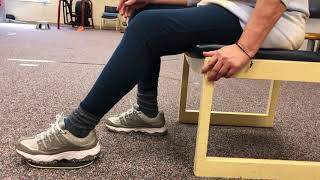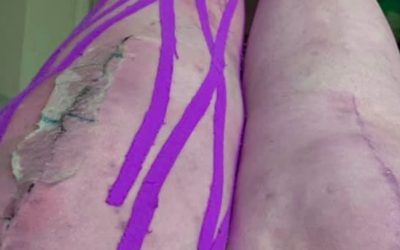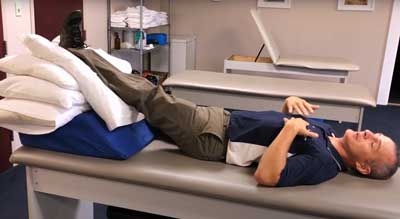Calf Pain After Knee Replacement
Calf and thigh pain is common after a total knee replacement. Calf pain may be caused by sore muscles due to increased swelling, altered walking mechanics, limited range of motion, and performing new exercises like ankle pumps and heel slides.
Tight Calf Muscles After a Knee Replacement May be Caused by New Alignment
After a total knee replacement, your new knee changes the alignment of the hip and ankle.
Many clients have some form of bowing in their leg before surgery.
Genu Varum also known as bow-legged is when the knee curves outward.
Genu Valgum also known as knock-kneed is when the knee curves inward.
Prior to surgery, your body has adapted to these mechanical changes over many years of your life. Now your new knee has changed decades of malalignment in 30-minutes. It is normal for your body to several weeks or months to adapt.
* Recommendation: Talk to your physical therapist to learn which exercises you can do to normalize your alignment and improve hip and ankle mobility in the process.
Calf and Ankle Pain After A Knee Replacement
Since a new knee changes the alignment of the whole leg it is common to experience ankle and calf pain during your recovery.
If the knee curved inward before surgery ‘Genu Valgum’ then the new, straight knee will increase medical ankle compression and may cause pain on the inside of the ankle.
* Recommendation: Your physical therapist may prescribe several exercises that increase ankle ‘eversion’ to improve the mobility of the inside ankle.
Conversely, if the knee curved out ‘Genu Varum’ before surgery then pain at the outside of the ankle may be more commonly experienced after surgery.
* Recommendation: Your physical therapist may prescribe several exercises that increase ankle ‘inversion’ to improve the mobility of the outside ankle.
These are normal symptoms and should improve in a few weeks of walking and joint specific exercises.
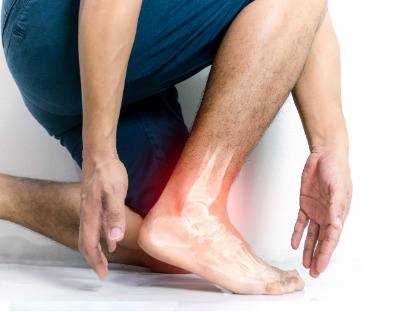
Why is my calf so tight after knee replacement surgery?
Swelling – as the edema or swelling starts to accumulate in the lower leg that fluid is pushing in as much as it pushes out.
Imagine someone squeezing your muscles 24-hours a day, 7-days a week. That would start to become painful.
Since you are not walking and moving as much as you normally would your swelling does not have the ability to move out of the lower leg and back into the system.
* Recommendations: Some therapists will perform compression wrapping to move the fluid out of the lower leg. You may have also been told to elevate your leg to reduce swelling. Finally, as you become more mobile and start walking more the act of walking will help squeeze some of the fluid out of your ankle and calf.
Below is Amazon’s “Best Overall Massage Gun” Pick for 2021
What can I do to reduce the calf pain?
To reduce calf pain and lower leg swelling you should schedule a time to stand and walk every one to two hours during your first two weeks after surgery.
You may also have been prescribed compression stockings by your surgeon or physical therapist. You should use these as prescribed.
You may try some form of self-massage. Here is a video of a rolling pin massage that is commonly recommended after knee replacement.
Tight Calf Muscles After Surgery
Stretching can be an effective strategy to reduce calf muscle tightness. These wedges are sold on Amazon as tire chocks and are incredibly effective for stretching a calf muscle.
Stretching may be performed after a rolling pin massage for better results. The massage will help warm up the muscle and promote fluid exchange. Then the stretch will help lengthen the muscle.
Shin and Ankle Pain
Sometimes clients will experience shin and ankle pain after knee replacement surgery. This too is usually caused by the new alignment of the knee as well as increased activity levels.
Before surgery, many clients were unable to walk and exercise due to pain. After surgery and during physical therapy many clients are doing far more than they are accustomed to doing. This increase in activity may account for shin pain in the bone or muscles alongside the bone.
Another common report is pain and the front of the ankle. This may be due to tightness between the tibia and fibula (which are the bones of the lower leg.)
Massages and stretching of these areas can be a great way to alleviate this pain.
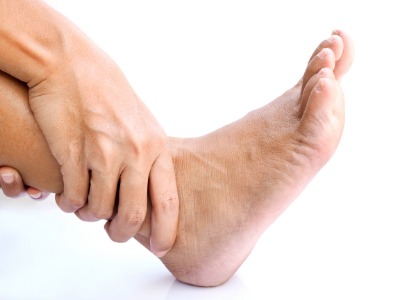
Calf Pain May Persist for Several Weeks or Months After A Knee Replacement
Since there are so many possible causes of pain in the calf and ankle, it is impossible to determine how long the associated pain will last.
For most clients, their symptoms will resolve in the first 6 to 12 weeks. If pain persists beyond that timeframe without a known cause it is recommended that you consult with your surgical team and physical therapist for further medical assessment.
To See Video 1 Look Below:
Heel Slides After Knee Surgery
"I would like to know when we can officially give up the darn heel slides and other stretch exercises, or do we need to continue forever?" Heel slides after knee surgery are just one of many exercises available to increase range of motion, reduce swelling, and regain...
Does RockTape Kinesiology Tape Help Recovery After Total Knee Replacement
Yes, kinesiology tape has been studied and may be effective for patients following total knee replacement surgery. Here is a quote from a recent study concluding: "KT technique appeared to be beneficial for reducing postoperative pain, edema, improving knee extension...
5 Best Wedge Pillows for Total Knee Replacement
What is a wedge pillow? A wedge pillow is literally what it sounds like, a pillow shaped like a wedge. Wedge pillows are commonly used for people who have sleep apnea or breathing issues at night. They are also used for any condition in which a person needs to keep...
Best walking shoes after knee replacement surgery in 2022
Best Shoes After Knee Replacement: What should I wear immediately after knee replacement surgery? What are the best shoes to wear at home? At Physical Therapy?
Scheduling A Massage After Knee Replacement Surgery
Massage therapy is an effective treatment in post-surgical care to reduce pain, improve swelling, and help return patients to daily activities. Several studies have investigated the benefits of massage therapy as soon as 2 days after total knee replacement surgery....
When Can I Drive After Total Knee Replacement Surgery?
You may typically resume driving 6 weeks after total knee replacement surgery. In the US, some surgeons will allow people who had their left knee replacement resume driving sooner. The most important factor to getting clearance to drive is your ability to walk...
